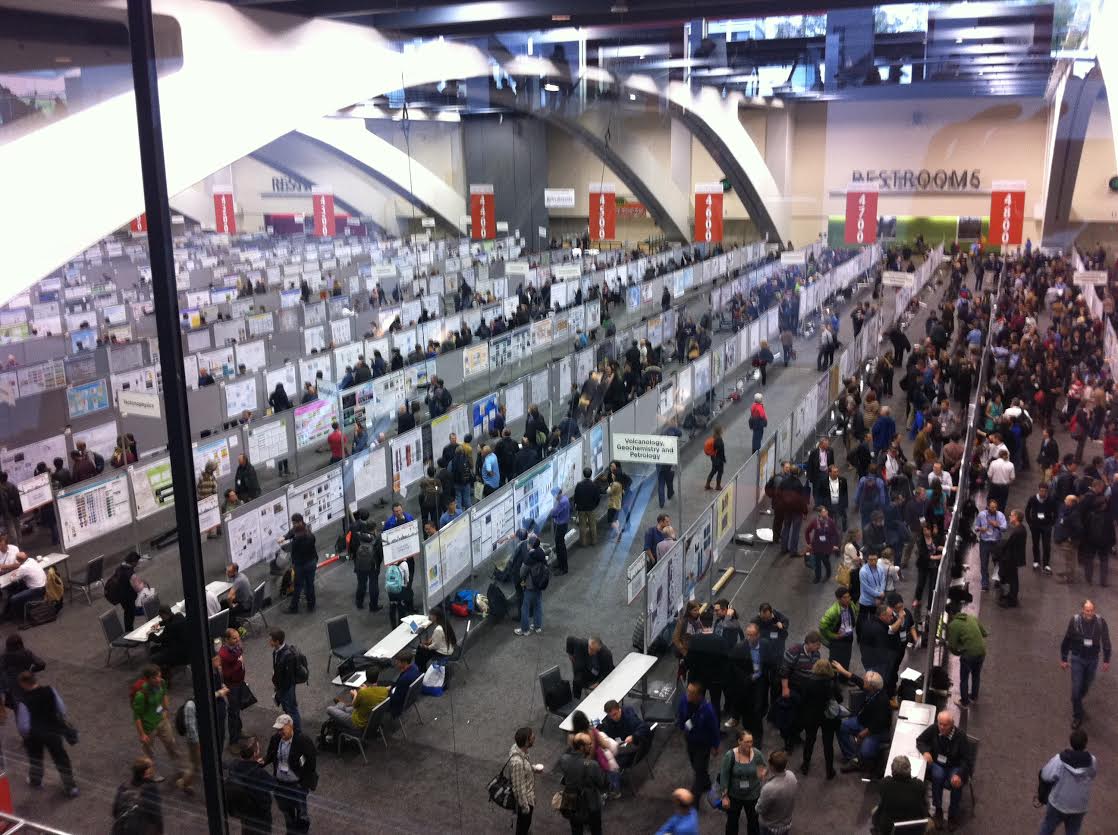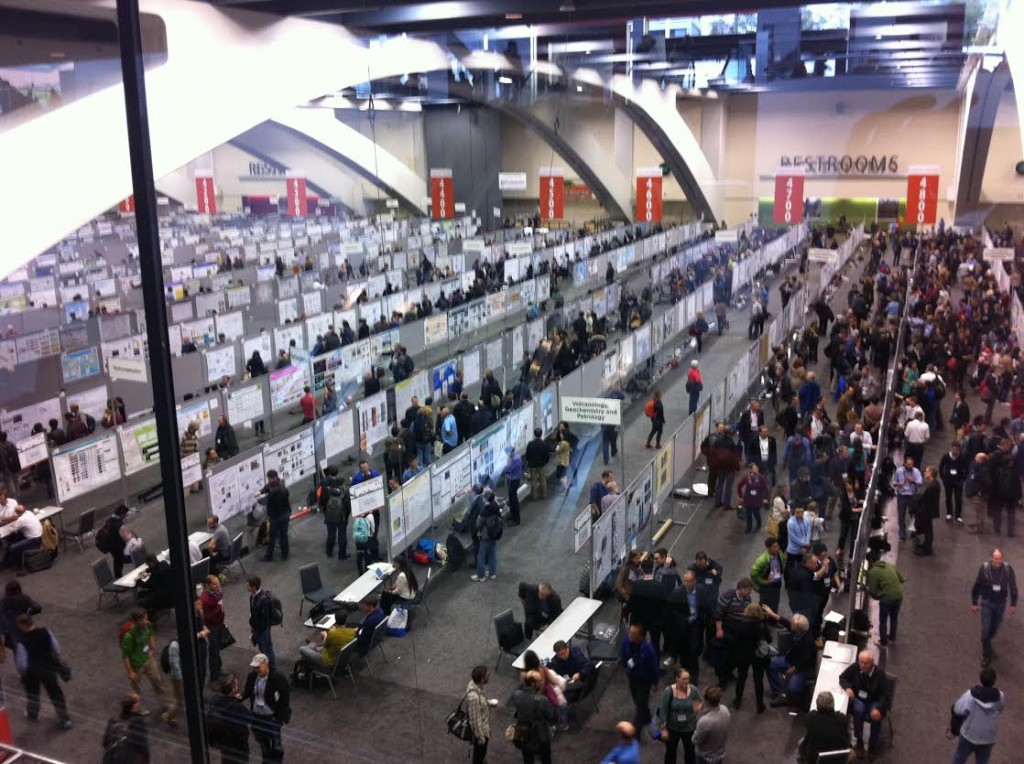At the end of 2014, a number of the Geology and Geophysics Research Group made the annual migration to San Francisco for the American Geophysical Union fall meeting. With nearly 24,000 attendees, and 23,000 poster and oral presentations, AGU is the world’s largest Earth and Space science meeting, providing an excellent stage to communicate and discuss current research and ideas. With such expansive numbers you are always sure to find others in your research niche.
Seventeen members of Southampton University’s Geology and Geophysics Research Group were associated with research presented at AGU this year, covering our diverse range of studies, from the thickening of the lithosphere by plume pulsing beneath Iceland, to the characteristics of methane hydrate and free gas reservoirs at the Nyegga Pockmark.
Oral presentations from the G&G group included:
Casey Nixon on Spatial and temporal variations in fault activity during early development of rift polarity within the offshore Corinth rift, central Greece. (Link)
Catherine Rychert on Seismic Imaging of Thickened Lithosphere Caused by Plume Pulsing beneath Iceland. (link).
Nick Harmon on Rayleigh and Love wave phase velocity maps of Iceland from combined ambient noise and teleseismic surface wave analysis. (link)
Savas Ceylan on Estimating Moho depth utilizing S-wave receiver functions. (link)
Gaye Bayrakci on 3D P-Wave Velocity Structure of the Deep Galicia Rifted Margin.
Casey Nixon on Spatial and temporal variations in fault activity during early development of rift polarity within the offshore Corinth rift, central Greece. (Link)
Catherine Rychert on Seismic Imaging of Thickened Lithosphere Caused by Plume Pulsing beneath Iceland. (link).
Nick Harmon on Rayleigh and Love wave phase velocity maps of Iceland from combined ambient noise and teleseismic surface wave analysis. (link)
Savas Ceylan on Estimating Moho depth utilizing S-wave receiver functions. (link)
Gaye Bayrakci on 3D P-Wave Velocity Structure of the Deep Galicia Rifted Margin.
Poster presentations from the G&G group included. (link)
Bedanta Goswami on Controlled Source Electromagnetic (CSEM) and Seismic Interpretation of Fluid Escape Features at the Vestnesa Ridge, West Svalbard Continental Margin (link)
Eric Attias on A Marine Controlled-Source Electromagnetic Study for the Characterization of Methane Hydrate and Free Gas Reservoirs at the Nyegga CNE03 Pockmark, Norwegian Sea. (link) (Another blog post on this subject can be found here).
Eric Attias on A Marine Controlled-Source Electromagnetic Study for the Characterization of Methane Hydrate and Free Gas Reservoirs at the Nyegga CNE03 Pockmark, Norwegian Sea. (link) (Another blog post on this subject can be found here).
Jennifer Neale on Infragravity Wave Generation and Reflection Off the Coast at Oregon, USA. (link)
Marianne Karplus on P-wave velocity structure offshore central Sumatra: implications for compressional and strike-slip faulting.(link)
Richard Davy on Searching for the Onset of Seafloor Spreading West of Galicia: Wide-Angle Seismic Constraints. (link)
Marianne Karplus on P-wave velocity structure offshore central Sumatra: implications for compressional and strike-slip faulting.(link)
Richard Davy on Searching for the Onset of Seafloor Spreading West of Galicia: Wide-Angle Seismic Constraints. (link)
We also had many co-authors associated with an impressive number of different studies that were presented. Apologies to anyone I may have missed!
As a first time attendee, I was initially overwhelmed by the incredible amount of science which was on offer, and I quickly realised the implausibility of trying to attend everything I wanted to see. Alterations to my personal AGU program were constantly being made as I bounced from presentations related to my own research (tectonophysics), to others which were completely unrelated to my field, such as biogeosciences, atmospheric, geodetic, magnetospheric and planetary science. Attending talks outside of my field gave me a fantastic understanding of some of the different scientific problems and how they a being addressed, or alternatively left me utterly bewildered and in awe of the complexity of the research. Two presentations really stood out from the rest for me, the first was given by Ellen Stofan (NASA’s chief scientist) on the search for Earth-like planets in the Solar system and beyond, while the second was given by Susan Beck on the seismic imaging of the Central Andes using 20 years of seismology data.
Attending the poster sessions was a very valuable experience, not only for the rows upon rows of science being presented, but for the ability to network with the abundance of researchers working on studies related to my own. After three hours of presenting my own poster, I had met a wealth of people interested in what I was doing and was left with a plethora of ideas and suggestions to apply to my own research. Posters were also a great way of tracking down people you wanted to meet for the first time, or to reunite yourself with, while discussing their current research.
On Wednesday, the mid-point of the conference, the G&G group met at Michelangelo’s, a local Italian restaurant, for a meal amongst some classical sculptures and to catch up with everyone else’s progress at the meeting. After excellent food and company, some of the more energetic members of the group, led by Casey Nixon, continued their “scientific discussions” in a number of local establishments, followed by a walking tour of the San Francisco skyline before ending the evening with some competitive shuffle board action.
A personal highlight of the conference for me came when I attended a talk on New Zealand’s Alpine Fault, only to see previous research of mine being shown and expanded upon. It is a very satisfying feeling to know that your work is being utilised and shown to such a large audience, even with a horrendous spelling of my name in the citation.
It is fair to say that most of us had filled our quota of science talks, posters and networking by the time 6 pm rolled around on Friday. As an early career scientist, AGU was a superb and valuable experience, and I am very glad for the opportunity to travel to San Francisco and present my research as a part of the G&G group. I will look forward to another winter migration in the future!
Author: Richard Davy

